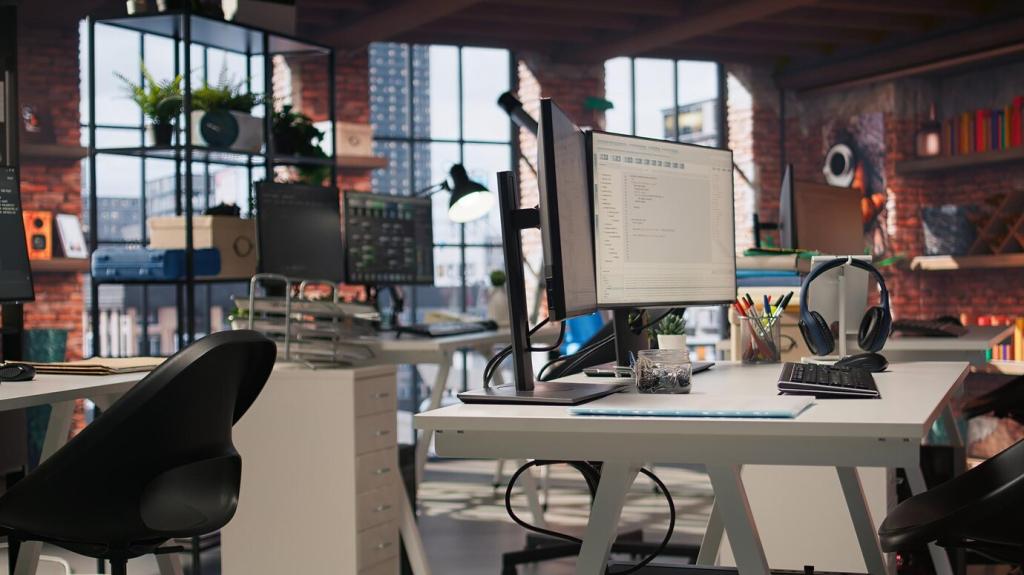Sustainable and Eco-Friendly Home Office Design Solutions
Designing a home office that harmonizes with sustainable and eco-friendly principles not only enhances personal productivity but also contributes positively to the environment. Thoughtful choices in materials, energy usage, furnishings, and decor can significantly reduce your workspace’s carbon footprint. This page delves into innovative strategies and solutions to create a greener, healthier, and more efficient home office. From efficient lighting to responsible material sourcing, every aspect of your workspace can play a role in building an office you can be proud of—in both aesthetics and environmental impact.

Reclaimed and Recycled Furnishings
Incorporating reclaimed wood desks, recycled metal shelving, or office chairs made from post-consumer plastics is a powerful way to minimize waste and reduce demand for new raw materials. These pieces bring unique character to your workspace and often come with a story, fostering a more personal connection to your office. Through careful selection, you can enjoy durable, attractive furniture while lessening your environmental impact. Many manufacturers now craft home office products from landfill-diverted items or sustainable steel, providing high-quality options that do not sacrifice style or function. By favoring such products, you support the transition to a circular economy and help lower the overall carbon footprint associated with office furniture.
Low-VOC and Non-Toxic Finishes
When designing an eco-friendly home office, indoor air quality is as crucial as the sourcing of materials. Many paints, finishes, and adhesives release volatile organic compounds (VOCs) that harm health and the environment. Low-VOC or zero-VOC finishes can significantly reduce the presence of harmful airborne chemicals, leading to a safer, fresher work atmosphere. Look for certifications and labels that indicate minimal emissions, such as Greenguard certified finishes. Water-based paints and natural oils provide lasting coverage without compromising the environment or your well-being. Integrating non-toxic materials is especially important if your workspace is compact or lacks robust ventilation, as it helps maintain optimal air quality during long workdays.
Sustainable Flooring Options
Flooring forms the backbone of any room design, and eco-conscious choices can make a significant difference. Materials such as bamboo, cork, or reclaimed hardwood offer rapid renewability or divert resources from landfills. Bamboo, for example, grows quickly with minimal pesticide and fertilizer requirements, making it a highly sustainable option. Cork, harvested without harming the tree, provides comfort underfoot and natural antimicrobial properties. Ensure adhesives used during installation are low in VOCs to further reduce emissions. Sustainable flooring not only looks beautiful but is also durable and easy to maintain, supporting your green home office vision for years to come.
LED Lighting and Smart Controls
Transitioning to LED lighting is one of the simplest yet most effective changes you can make. LEDs use up to 80% less energy than traditional bulbs and last far longer, reducing both cost and waste. Choose fixtures that direct light efficiently onto work surfaces while minimizing glare. Integrate smart controls like dimmers, occupancy sensors, or timers to further optimize energy use. Automated lighting systems ensure lights are only in use when necessary, aligning energy consumption with your work habits. These solutions not only support the planet but also provide adjustable, comfortable illumination that can combat fatigue and enhance productivity.
Energy Star Certified Equipment
Investing in Energy Star certified electronics is a smart move for a sustainable home office. Laptops, monitors, printers, and other peripherals with Energy Star certification meet rigorous energy-efficiency guidelines set by environmental agencies. These devices often include sleep or auto-off modes, modular power supplies, and other features that drastically reduce energy demand during inactive periods. Over time, shifting to efficient technology can make a notable difference in both emissions and operating costs. Additionally, streamlined and smaller devices not only consume less energy but also help reduce resource consumption during manufacturing, installation, and disposal.
Sustainable Office Organization Solutions
01
Green storage options abound for the modern home office. Look for shelving and organizers made from bamboo, recycled plastics, or repurposed wood to minimize the purchase of virgin materials. Modular designs can adapt to changing office needs, extending product lifespan and reducing waste. Choose storage bins crafted from biodegradable materials or responsibly sourced fibers, such as jute or organic cotton, instead of petrochemical-based plastics. These choices can help streamline your office while emphasizing environmental responsibility. Implementing eco-friendly storage demonstrates that sustainable design extends well beyond major furniture and into the finer organizational details.
02
Achieving a clutter-free workspace doesn’t need to come at the environment’s expense. Before discarding items, consider donating, selling, or recycling them to extend their useful life and keep waste out of landfills. Practice mindful purchasing by bringing in only what you truly need and favoring digital solutions over physical paperwork where possible. This approach minimizes the accumulation of unnecessary items and supports a more intentional, less wasteful office. Emphasizing quality over quantity in supplies and décor reduces the frequency of replacement and the environmental burden associated with constant consumption.
03
Handling waste properly is a critical component of a green home office. Set up an accessible recycling system for paper, packaging, electronics, and batteries to keep harmful materials from entering the environment. If local facilities permit, compost food and plant-based waste from snacks or desk plants. Opt for refillable pens, recycled paper products, and other reusable office supplies to minimize disposables. Staying informed about responsible e-waste disposal options, including manufacturer take-back programs, is essential when upgrading equipment. These strategies ensure that waste produced in your office is managed in the most eco-friendly manner possible, aligning daily habits with broader sustainability goals.
